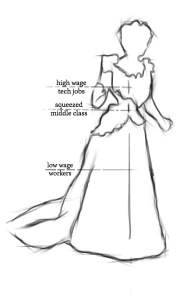July 24, 2014 marks the fifth anniversary of the last federal minimum wage increase and insodoing, marks the fifth year that Congress has ignored a glaring inequality in American society. Those seven dollars and twenty-five cents are worth less now than when enacted; even the minimum wage of 1968 — only $1.60 per hour — had a higher buying power than today’s federal floor.
While some in Congress insist that an increase in the minimum wage is extravagant, President Obama has fought for a $10.10 nationwide standard. That effort has included an executive order to pay all federal employees and this week, several House Democrats are attempting to live on the minimum wage for one week.
However, Republican intransigence has forced states and cities to take their own actions. Ten states have legislated increases in the minimum wage in 2014 alone. Massachusetts will reach a minimum wage of $11 by 2017. Seattle goes one step further, asking employers to pay $15 an hour by 2017. In July, California’s minimum received a scheduled increase up to $9 an hour.
It’s time to take the fight local. Two of the 10 most unequal cities in America are right here in the Bay Area: San Francisco and Oakland. Even closer to home, Palo Alto criminalized homelessness last summer. While San Francisco considers an increase to $15, we must ensure that the workers who support our campus and our community are also able to support themselves.
In many ways, Silicon Valley is ground zero for economic inequality in America. For Stanford students and people like us — programmers, engineers and other highly educated professionals — decent wages are a given, and tech companies compete to provide the best free food and other perks. But for the people who cook that food, clean our buildings and otherwise keep our lives running smoothly, it’s incredibly difficult to make ends meet.
In 2010, one-third of Santa Clara County households earned less than the Self-Sufficiency Standard, a measure of basic expenses for food, housing, transportation, child care and other necessities. Wages simply aren’t keeping pace with the cost of living: The median household in Silicon Valley saw its real income fall by 19.5 percent between 2000 and 2010.

Our region has a “Victorian gown” economy: high-wage tech positions for those with advanced skills, an overly-squeezed middle class and a glut of low-wage service sector jobs for everyone else.
The Stanford bubble is not immune to this problem. After years of advocacy by students and campus workers, in 2007 the University adopted a living wage policy that ensures service workers on campus are paid at least $12.85 plus either health care benefits or a stipend to buy insurance. While that’s better than both the state and federal standards, it’s still far below the cost of living in Silicon Valley ($19.39/hour for a family of four with both parents working full-time). And due to various exemptions, many Stanford workers aren’t even guaranteed the living wage.
Sadly, tech companies — which we think of as hotbeds of innovation — have also been stagnant on this front. While Apple and Google post massive profits, their custodians, food service workers and security officers are struggling to put food on the table. At Apple, a group of security officers has been trying to change this, organizing to demand quality jobs. Apple has chosen to pass the buck, claiming that since it pays a contractor to provide security, the officers are technically not their employees.
That attitude is disingenuous, and it’s misguided. Fair wages and working conditions would barely dent profits for most tech companies, and it would strengthen Silicon Valley. We all do better when workers can take care of their families and support local businesses. States that have raised their minimum wages have seen faster job growth than those that haven’t. Nationally, boosting the minimum wage to $10.10 an hour would grow our GDP by $22 billion.
Seventy-one percent of Americans favor increasing the minimum wage. Whether you support it or not, we challenge you to live on the minimum wage for one week. During the academic year, Stanford’s tuition and fees will cost you about $1,900 per week. Starting Thursday, try living on just $77 – a minimum wage worker’s budget for food and transportation. Visit www.LiveTheWage.com and use #LiveTheWage to chronicle your experiences.
But more than that, ask your state and federal representatives to participate. And then ask them to raise the minimum wage. Hopefully, asking the former will accomplish the latter.
If nothing else, next time you’re on campus, look the person serving your food in the eye, or ask a cleaning staff member how her day is and consider how we can better support those who enable our campus, our region and our nation to succeed.
Nick Ahamed (‘15) is a Political Science major and the former president of the Stanford Democrats. Contact him at [email protected].
Jeff Barrera (‘15) is an Urban Studies major and intern with Working Partnerships USA. Contact him at [email protected].